Polaris GEM eM1400 LSV User Manual

GEM eM™ 1400 LSV
eM™ 1400 LSV
2015 Owner's Manual
for Maintenance and Safety

 WARNING
WARNING
Read, understand, and follow all of the instructions and safety precautions in this manual and on all product labels.
Failure to follow the safety precautions could result in serious injury or death.

WELCOME
Thank you for purchasing a GEM by POLARIS, and welcome to our world-wide POLARIS family of recreational and utility vehicle owners. We believe POLARIS sets a standard of excellence for all recreational and utility vehicles manufactured in the world today. With our many years of experience in design and manufacturing, we proudly bring you only the finest of vehicles:
•Snowmobiles
•All-terrain vehicles (ATVs)
•Low emission vehicles (LEVs)
•RANGER® utility vehicles
•RZR® sport vehicles
•VICTORY® motorcycles
•GEM® electric vehicles
For safe and enjoyable operation of your vehicle, be sure to follow the instructions and recommendations in this owner’s manual. Your manual contains instructions for minor maintenance, but information about major repairs is outlined in the GEM Service Manual and should be performed only by an authorized GEM dealer technician.
If questions arise after reading the manual, please contact GEM customer service. Be prepared to provide your Vehicle Identification Number (VIN) and date of purchase.
Your authorized GEM dealer knows your vehicle best and is interested in your total satisfaction. Be sure to return to your dealership for all of your service needs during, and after, the warranty period.
GEM Customer Service
Phone: 855-RIDEGEM (855-743-3436) Web: www.gemcar.com
1
POLARIS®, GEM® and eM™ are trademarks of POLARIS Industries Inc. Global Electric Motorcars® is a division of POLARIS.
Copyright 2014 POLARIS Industries Inc. All information contained within this publication is based on the latest product information at the time of publication. Due to constant improvements in the design and quality of production components, some minor discrepancies may result between the actual vehicle and the information presented in this publication. Depictions and/or procedures in this publication are intended for reference use only. No liability can be accepted for omissions or inaccuracies. Any reprinting or reuse of the depictions and/or procedures contained within, whether whole or in part, is expressly prohibited.
The original instructions for this vehicle are in English. Other languages are provided as translations of the original instructions.
Printed in U.S.A.
2015 GEM® eM™ 1400 LSV Owner’s Manual P/N 9925921
2
TABLE OF CONTENTS
Introduction . . . . . . . . . . . . . . . . . . . . . . . . . . . . . . . . . . . . . . . . 4
Safety . . . . . . . . . . . . . . . . . . . . . . . . . . . . . . . . . . . . . . . . . . . . . 7
Features and Controls . . . . . . . . . . . . . . . . . . . . . . . . . . . . . . . 18
Operation . . . . . . . . . . . . . . . . . . . . . . . . . . . . . . . . . . . . . . . . . 32
Winch Guide . . . . . . . . . . . . . . . . . . . . . . . . . . . . . . . . . . . . . . . 43
Maintenance . . . . . . . . . . . . . . . . . . . . . . . . . . . . . . . . . . . . . . . 52
Specifications. . . . . . . . . . . . . . . . . . . . . . . . . . . . . . . . . . . . . . 68
Troubleshooting . . . . . . . . . . . . . . . . . . . . . . . . . . . . . . . . . . . . 69
Warranty . . . . . . . . . . . . . . . . . . . . . . . . . . . . . . . . . . . . . . . . . . 70
Maintenance Log . . . . . . . . . . . . . . . . . . . . . . . . . . . . . . . . . . . 74
Index . . . . . . . . . . . . . . . . . . . . . . . . . . . . . . . . . . . . . . . . . . . . . 76
3

INTRODUCTION
This vehicle complies with the U.S. Department of Transportation National Highway Traffic Safety Administration (NHTSA) low-speed vehicle regulations and can be operated on many streets posted with low speed limits. Please familiarize yourself with all laws and regulations concerning the operation of the vehicle in your area.
The following signal words and symbols appear throughout this manual and on your vehicle. Your safety is involved when these words and symbols are used. Become familiar with their meanings before reading the manual.
The safety alert symbol indicates a potential personal injury hazard.
DANGER
A DANGER indicates a hazardous situation that, if not avoided, will result in death or serious injury.
WARNING
A WARNING indicates a hazardous situation that, if not avoided, could result in death or serious injury.
CAUTION
A CAUTION indicates a hazardous situation that, if not avoided, could result in minor or moderate injury.
NOTICE
A NOTICE indicates a situation that could result in property damage.
The Prohibition Safety Sign indicates an action NOT to take in order to avoid a hazard.
The Mandatory Action Sign indicates an action that NEEDS to be taken to avoid a hazard.
4

INTRODUCTION
 WARNING
WARNING
Failure to follow the warnings contained in this manual can result in severe injury or death. Special precautions must be followed when operating or servicing a battery-powered vehicle. This vehicle handles differently than other vehicles. A collision or rollover can occur quickly, even during routine maneuvers, if you fail to take proper precautions.
•Read this owner’s manual. Understand all safety warnings, precautions and operating procedures before operating the vehicle. Keep this manual with the vehicle at all times.
•This vehicle is an ADULT VEHICLE ONLY. You MUST be at least age 16 and have a valid driver’s license to operate this vehicle.
•No person under the age of 12 may ride as a passenger in this vehicle.
•Never permit a guest to operate this vehicle unless the guest has read this manual and all product labels.
•Never use this vehicle with drugs or alcohol, as these conditions impair judgment and reduce operator reaction time.
•Operate this vehicle only on public or private roads where speed limits are appropriate for low speed vehicles. Be familiar with motor vehicle laws in your area of operation. Do not operate this vehicle in situations where it could become an obstacle or an annoyance for faster-moving traffic.
5
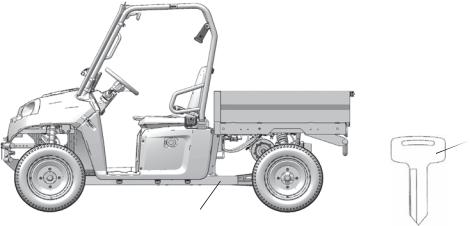
INTRODUCTION
Vehicle Identification Numbers
Record your vehicle's identification numbers and key number in the spaces provided below. The Vehicle Identification Number (VIN) indicates the model year, model type and serial number of your vehicle. The VIN is stamped on the left rear frame. The VIN is also on the manufacturer’s label, which is located under the passenger seat. Gross Vehicle Weight information for your vehicle is on the Passenger/Tire Pressure Warning Label in the rear cargo box. See page 7.
To order an extra or replacement key for your vehicle, please contact GEM customer service. See page 1. Be prepared to provide your key number and VIN. Remove the spare key and store it in a safe place. A key can be duplicated only by ordering a key blank (using your key number) and mating it with one of your existing keys. The key switch must be replaced if all keys are lost.
Key
Number
####
Frame VIN
Vehicle Model Number: ________________________________________________________________________
Frame VIN: _________________________________________________________________________________
Motor Serial Number (on side of motor): ___________________________________________________________
Key Number: ________________________________________________________________________________
6
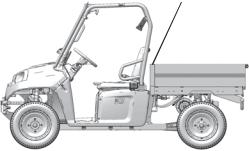
SAFETY
Safety Labels and Locations
Warning labels have been placed on the vehicle for your protection. Read and follow the instructions of the labels on the vehicle carefully. If any of the labels depicted in this manual differ from the labels on your vehicle, always read and follow the instructions of the labels on the vehicle.
If any label becomes illegible or comes off, contact your GEM dealer to purchase a replacement. Replacement safety labels are provided at no charge. The part number is printed on the label.
Passenger/Tire Pressure Warning
WARNING
•Passengers can be thrown off. This can cause serious injury or death.
•Never carry passengers in cargo box.
WARNING
IMPROPER TIRE PRESSURE OR OVERLOADING CAN CAUSE LOSS OF CONTROL RESULTING IN SERIOUS INJURY OR DEATH.
•Reduce speed and allow greater distance for braking when carrying cargo.
•Overloading or carrying tall, off-center, or unsecured loads will increase your risk of losing control. Loads should be centered and carried as low as possible in box.
•For stability on rough or hilly terrain, reduce speed and cargo.
•Be careful if load extends over the side of the box.
Passenger/Tire Pressure
Warning
(inside box on front panel)
eM1400 LSV |
BASE |
BASE WITH |
BASE WITH VAN |
|
|
SIDES |
ENCLOSURE |
TIRE PRESSURE IN PSI (KPa) |
FRONT 35 (241) |
FRONT 35 (241) |
FRONT 35 (241) |
|
REAR 35 (241) |
REAR 35 (241) |
REAR 35 (241) |
VEHICLE OPERATING WEIGHT |
1703 lbs. |
1758 lbs. |
1828 lbs. |
|
(772 kg) |
(797 kg) |
(829 kg) |
MAXIMUM CARGO PAYLOAD |
900 lbs. |
845 lbs. |
775 lbs. |
|
(408 kg) |
(383 kg) |
(351 kg) |
GVW = VEHICLE + OCCUPANTS + |
2953 lbs. |
2953 lbs. |
2953 lbs. |
PAYLOAD + ACCESSORIES |
(1339 kg) |
(1339 kg) |
(1339 kg) |
Read Operation and Maintenance Manual for more detailed loading information. |
|||
|
|
|
7181724 |
7
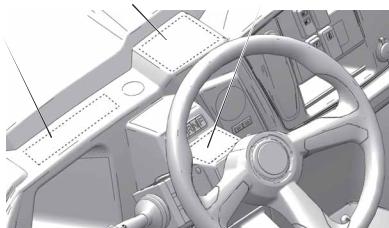
SAFETY
Safety Labels and Locations
Battery |
Age 16 |
Caution |
Warning |
Discretionary |
|
Warning |
|
Age 16 Warning
Operating this vehicle if you are under the age of 16 increases your chance of severe injury or death.
NEVER operate this vehicle if you are under age 16 and NEVER operate this vehicle without a valid driver’s license.
7175566
Discretionary Warning
WARNING
Improper vehicle use can result in Severe Injury or Death. NEVER Operate:
•At speeds too fast for your skills or the conditions.
•After or while using Alcohol or Drugs.
•On extreme off-road terrain or extreme slopes.
•With more than one passenger, or a passenger under age twelve or who cannot comfortably reach the floor and hand holds.
•With non-POLARIS approved accessories - they may seriously affect stability.
ALWAYS:
•Wear your seat belt, if equipped. Vehicle rollover could cause severe injury or death.
•Wear eye protection and keep hands and feet in vehicle at all times. Wear a helmet when appropriate.
•Reduce speed and use extra caution when carrying a passenger.
•Avoid sharp turns or turns while applying heavy throttle.
•Operate slowly in reverse - avoid sharp turns or sudden braking.
•Make sure passenger reads and understands all safety labels.
•Watch for branches or other hazards that could enter vehicle.
LOCATE AND READ OWNER’S MANUAL. FOLLOW ALL INSTRUCTIONS AND WARNINGS.
7182157
8
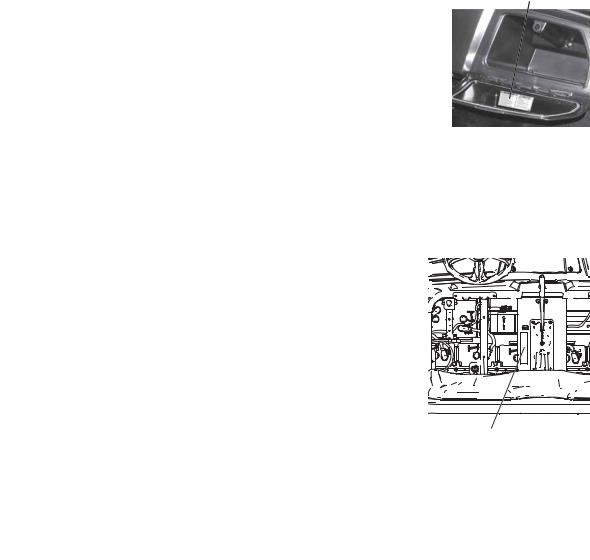
SAFETY
Safety Labels and Locations
Battery Caution
CAUTION
•Do not drive through water above the floor of the vehicle. Battery damage will occur.
•Batteries require regular maintenance.
•Failure to maintain batteries in accordance with the owners manual can result in battery damage, vehicle malfunction, fire and/or severe injury or death.
•Max towing speed 10 MPH (16 km/h) - drivetrain damage will occur if towed faster than 10 MPH (16 km/h).
•Set parking brake before leaving vehicle.
•Turn Power On key to “Off” position and remove when not in use.
•When towing vehicle, turn Power On key to “Off” position.
7180693
Battery Charging Warning
WARNING
•Explosive gases are released when batteries are charged. Keep sparks, flames and cigarettes away. Shield eyes when working near batteries.
•Do not charge batteries in a non-ventilated enclosed area or near flammable materials.
•Do not attempt to charge frozen, leaking, or damaged batteries.
•Connect battery charger to properly rated electrical receptacle with GFCI.
•Do not charge with storage or weather cover on vehicle or with the cab enclosure doors closed, as fire and explosion are possible.
Battery Charging
Warning
•Refer to Owner’s Manual or contact your local dealer with any questions.
TO MAXIMIZE BATTERY LIFE
•Always check and maintain water level monthly. Use only distilled water. Water level should be kept 1/ 4” (6 mm) below fill well. Do not overfill the battery.
•Always keep batteries fully charged. For maximum life, charge your vehicle at every opportunity. Use only the charger supplied with the vehicle. Inspect battery connections regularly.
•Failure to properly maintain your batteries will void warranty coverage.
Battery Compartment Warning
WARNING
•SULFURIC ACID in batteries will burn skin, eyes, and clothing. Always wear eye protection and proper clothing. Do not tip batteries. Keep vent caps tight and level. In event of injury, flush with water and call physician immediately.
•HIGH VOLTAGE CABLES and terminals are contained within this compartment. Improper contact between battery terminals can result in electrical shorts. ELECTRICAL SHORTS can result in burns.
•Do not use high pressure water to wash the battery compartment. Damage to the vented batteries will result.
•Tampering with or unauthorized modification of this unit could result in serious personal injury, will void the warranty, and can result in permanent damage to the vehicle.
•Refer to your Owner’s Manual or contact your local GEM dealer with any questions.
7180344
7176414
Battery Compartment
Warning
9

SAFETY
Personal Protective Equipment
Always wear the proper clothing when operating or riding in this vehicle. All riders should wear substantial footwear, long pants and a close-fitting shirt. A hard hat or helmet and approved eye protection are recommended when appropriate for working or riding conditions. GEM recommends wearing approved eye protection bearing markings such as VESC 8, V-8, Z87.1 or CE. Never operate or ride in this vehicle while barefoot or while wearing sandals or tennis shoes.
Workplace safety regulations may require the use of safety glasses, safety shoes and a hard hat or helmet. Familiarize yourself with local requirements, be prepared for operating conditions and wear the appropriate safety gear.
Operator Safety
 WARNING
WARNING
Serious injury or death can result if you do not follow these instructions and procedures, which are outlined in further detail within your owner's manual.
•Read this entire manual and all labels carefully. Follow the operating procedures described.
•Never allow anyone under the age of 16 to operate this vehicle and never allow anyone without a valid driver's license to operate this vehicle.
•Always make sure the seat belts are secured for operator and passenger before operating.
•Never permit a guest to operate this vehicle unless the guest has read this manual and all product labels.
•Do not carry a passenger until you have at least two hours of driving experience with this vehicle.
•No person under the age of 12 may ride as a passenger in this vehicle.
•Never carry more than one passenger in this vehicle.
•Never exceed the stated load capacity for this vehicle. Cargo should be properly distributed and securely attached. Reduce speed and follow the instructions in this manual for hauling cargo or pulling a trailer. Allow a greater distance for braking.
•This vehicle is a utility vehicle. The vehicle should not be operated on public streets having posted speed limits of more than thirty-five miles per hour (35 mph), state and local rules may vary. Check with your local law enforcement (city and state officials) for variations in your area.
•Always be sure there are no obstacles or people behind your vehicle when operating in reverse. When it's safe to proceed in reverse, move slowly. Avoid turning at sharp angles in reverse.
•Always use the proper size and type of tires specified in this manual. Always maintain proper tire pressure as specified on safety labels.
10
SAFETY
Operator Safety
•Never modify this vehicle through improper installation or use of non-GEM-approved accessories.
•Always set the park brake and remove the key when leaving the vehicle unattended.
•The voltage in the battery pack is sufficient to cause death by electrocution. With the exception of battery inspections and refilling the water in flooded type batteries, never attempt to perform service on the electric drive system, including the battery pack. See your GEM dealer.
•Always keep hands and feet inside the vehicle at all times. Always keep both hands on the steering wheel (driver) and both feet on the floorboards of the vehicle during operation.
•Never consume alcohol or drugs before or while operating this vehicle.
•Never operate at excessive speeds. Always operate at a speed that's appropriate for the traffic, the visibility and operating conditions, your skills and your passenger’s skills.
•Always inspect the vehicle before each use to make sure it's in safe operating condition. Always follow the inspection procedures described in this manual.
•Always travel slowly and use extra caution when operating on unfamiliar terrain. Be alert to changing terrain.
•Always follow proper procedures for turning. Make turns slowly, especially when the ground is wet, greasy, bumpy or sloping. Never turn the steering wheel abruptly when driving at high speed.
•Always have this vehicle checked by an authorized GEM dealer if it has been involved in an accident.
•Always be alert for obstacles when operating this vehicle. Never attempt to operate over obstacles.
•Do not drive through water above the floor of the vehicle. Battery damage will occur.
•Never operate this vehicle on steep hills.
•Always follow proper procedures for climbing hills as described in this manual. Check the terrain carefully before attempting to climb a hill. Never climb hills with excessively slippery or loose surfaces. Never go over the top of a hill at high speed.
•Always follow the proper procedures outlined in this manual for traveling downhill and for braking on hills. Check the terrain carefully before descending a hill. Never travel downhill at high speed. Avoid going downhill at an angle, which would cause the vehicle to lean sharply to one side. Travel straight down the hill where possible.
•Never operate on excessively rough, slippery or loose terrain.
•Always be careful of skidding or sliding. On slippery surfaces such as ice, travel slowly and exercise caution to reduce the chance of skidding or sliding out of control.
•Always be sure there are no obstacles or people behind your vehicle when operating in reverse. When it's safe to proceed in reverse, move slowly. Avoid turning at sharp angles in reverse.
11
SAFETY
Operator Safety
Gross Vehicle Weight Rating (GVWR)
WARNING! Exceeding the gross vehicle weight rating of your vehicle can reduce stability and handling and could cause loss of control. NEVER exceed the GVWR of your vehicle.
The maximum payload capacity of your vehicle is the maximum weight you may add to your vehicle without exceeding the GVWR. This capacity is determined by calculating the difference between your vehicle’s GVWR and wet weight.
Refer to the specification section of this manual or the Manufacturer’s Label on the vehicle for model-specific information.
When determining the weight you will be adding to your vehicle, and to ensure you do not exceed the maximum payload capacity, include the following:
•operator body weight
•passenger body weight
•weight of all occupants’ apparel and items in or on apparel
•weight of any options or accessories and their contents
•weight of any additional cargo on the vehicle
Equipment Modifications
Never install any accessory that grounds to the vehicle chassis. The chassis is a floating ground to protect against electrical short circuits and hazards.
Do not install any non-GEM-approved accessory or modify the vehicle for the purpose of increasing speed or power. Any modifications or installation of non-GEM-approved accessories could create a substantial safety hazard and increase the risk of bodily injury.
The warranty on your GEM vehicle will be terminated if any non-GEM-approved equipment and/or modifications have been added to the vehicle that increase speed or power.
The addition of certain accessories, including (but not limited to) mowers, blades, tires, sprayers, or large racks, may change the handling characteristics of the vehicle. Use only GEM-approved accessories, and familiarize yourself with their function and effect on the vehicle.
12
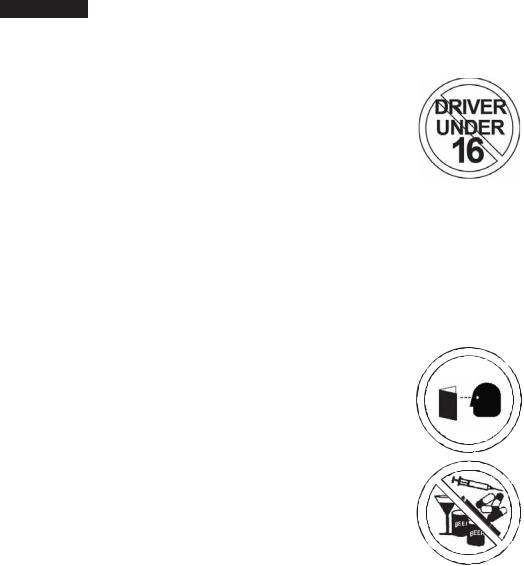
SAFETY
Operator Safety
 WARNING
WARNING
Failure to operate this vehicle properly can result in a collision, loss of control, accident or rollover, which may result in serious injury or death. Heed all safety warnings outlined in this section of the owner’s manual. See the OPERATION section of the owner’s manual for proper operating procedures.
Age Restrictions
This vehicle is an ADULT VEHICLE ONLY. NEVER operate this vehicle if you are under age 16 and NEVER operate without a valid driver’s license.
Never operate with a passenger under the age of 12.
Seat Belts
Riding in this vehicle without wearing the seat belt increases the risk of serious injury in the event of an accident or sudden stop. Occupants must wear seat belts at all times. Always make sure the seat belts are secured for both the operator and passenger before riding. See page 30.
Protective Apparel
Always wear the proper clothing when operating or riding in this vehicle. All riders should wear substantial footwear, long pants and a close-fitting shirt. A hard hat or helmet and approved eye protection are recommended when appropriate for working or riding conditions. GEM recommends wearing approved eye protection bearing markings such as VESC 8, V-8, Z87.1 or CE. Never operate or ride in this vehicle while barefoot or while wearing sandals or tennis shoes.
Operating Without Instruction
Operating this vehicle without proper instruction increases the risk of an accident. The operator must understand how to operate the vehicle properly in different situations and on different types of terrain.
All operators must read and understand the Owner's Manual and all warning and instruction labels before operating the vehicle.
Using Alcohol or Drugs
Operating the vehicle after consuming alcohol or drugs could adversely affect operator judgment, reaction time, balance and perception.
Never drink alcohol or use drugs or medications before or while operating this vehicle.
13
SAFETY
Operator Safety
Ventilation When Charging Batteries
Failure to provide adequate ventilation while charging batteries can result in an explosion. Volatile hydrogen gas is emitted during charging and may accumulate in pockets at the ceiling.
•Always ensure a minimum of 5 air changes per hour in the charging area.
•Always remove any storage covers from the vehicle and open any cab doors (if equipped) before charging.
•If the charger turns off due to an overheated condition (thermal cutback), remove the seat to improve air flow. Reset the charger (interrupt AC power for 15 seconds).
Failure to Inspect Before Operating
Failure to inspect and verify that the vehicle is in safe operating condition before operating increases the risk of an accident. Always perform the pre-ride inspection before each use of your vehicle to make sure it's in safe operating condition. See page 32.
Always follow all inspection and maintenance procedures and schedules described in this owner's manual. See page 52.
Operating With a Load on the Vehicle
The weight of both cargo and passengers impacts vehicle operation. For your safety and the safety of others, carefully consider how your vehicle is loaded and how to safely operate the vehicle. Follow the instructions in this manual for loading, tire pressure, gear selection and speed.
•Do not exceed vehicle weight capacities. The vehicle’s maximum weight capacity is listed in the specifications section of this manual and on a label on the vehicle. When more passenger weight is added, cargo weight may need to be reduced accordingly.
•The recommended tire pressures are listed in the specifications section of this manual and on a label on the vehicle.
Always follow these guidelines:
Under ANY of these conditions: |
Do ALL of these steps: |
||
Passenger and/or cargo exceeds half the maximum weight capacity |
1. Slow down. |
||
|
2. |
Verify tire pressure. |
|
Operating in rough terrain |
|||
3. |
Use extra caution when |
||
|
|||
Operating over obstacles |
|||
|
operating. |
||
|
|
||
Climbing an incline |
|
|
|
|
|
|
|
Towing |
|
|
|
|
|
|
|
14
SAFETY
Operator Safety
Operating a Damaged Vehicle
Operating a damaged vehicle can result in an accident. After any accident, have a qualified service dealer inspect the entire machine for possible damage, including (but not limited to) brakes, accelerator, steering system and electrical system.
Operating at Excessive Speeds
Operating this vehicle at excessive speeds increases the operator's risk of losing control. Always operate at a speed that's appropriate for the traffic, the visibility and operating conditions, your skills and your passenger’s skills.
Vehicle Rollover
Vehicle rollover could cause serious injury or death. The cab frame is not designed or intended to provide rollover protection. Always make sure the seat belts are secured for operator and passenger before operating. Avoid situations that could result in a rollover. Avoid sharp turns and abrupt steering maneuvers.
Driving Through Water
Do not drive through water above the floor of the vehicle. Battery damage will occur.
Turning Improperly
Turning improperly could cause loss of traction, loss of control, accident or rollover. Always follow proper procedures for turning as described in this owner’s manual. Never turn abruptly or at sharp angles. Never turn at high speeds. Practice turning at slow speeds before attempting to turn at faster speeds.
15
SAFETY
Operator Safety
Jumps and Stunts
Exhibition driving increases the risk of an accident or rollover. Never attempt wheelies, jumps, doughnuts or other stunts. Avoid exhibition driving.
Operating in Unfamiliar Terrain
Failure to use extra caution when operating on unfamiliar terrain could result in an accident or rollover. Unfamiliar terrain may contain hidden rocks, bumps, or holes that could cause loss of control or rollover.
Travel slowly and use extra caution when operating on unfamiliar terrain. Always be alert to changing terrain conditions.
Operating on Slippery Terrain
Failure to use extra caution when operating on excessively rough, slippery or loose terrain could cause loss of traction, loss of control, accident or rollover.
Do not operate on excessively slippery surfaces. Always reduce speed and use additional caution when operating on slippery surfaces.
Stalling While Climbing a Hill
Stalling or rolling backwards while climbing a hill could cause a rollover. Always maintain a steady speed when climbing a hill.
If all forward speed is lost:
•Apply the brakes.
•Switch to reverse and slowly allow the vehicle to roll straight downhill while applying light brake pressure to control speed.
If you begin rolling downhill:
•Never press the accelerator.
•Apply the brakes gradually until the vehicle is fully stopped.
•Switch to reverse and slowly allow the vehicle to roll straight downhill while applying light brake pressure to control speed.
Improper Hill Climbing
Climbing hills improperly can cause loss of control or vehicle rollover. Always follow proper procedures for climbing hills as described in the owner's manual. See page 35.
Improper Tire Maintenance
Operating this vehicle with improper tires or with improper or uneven tire pressure could cause loss of control or accident.
Always use the size and type of tires specified for your vehicle. Always maintain proper tire pressure as described in the owner's manual and on safety labels.
16
SAFETY
Operator Safety
Descending Hills Improperly
Improperly descending a hill could cause loss of control or rollover. Always follow proper procedures for traveling down hills as described in the owner's manual.
•Use the brake pedal to control speed when descending a hill. Never travel down a hill at high speed.
•Always descend a hill with the direction selector on FORWARD. Never descend a hill in neutral.
•Always check the terrain carefully before descending a hill.
•Avoid traveling down a hill at an angle, which would cause the vehicle to lean sharply to one side. Travel straight downhill.
Operating on Frozen Bodies of Water
Severe injury or death can result if the vehicle and/or the operator fall through the ice. Never operate the vehicle on a frozen body of water.
Unauthorized Use of the Vehicle
Leaving the keys in the vehicle can lead to unauthorized use of the vehicle by someone under the age of 16, without a drivers license, or without proper training. This could result in an accident or rollover. Always remove the key when the vehicle is not in use.
Hot Drive Systems
The motor and controller are very hot during and after use of the vehicle. Hot components can cause burns and fire. Do not touch hot drive system components. Always keep combustible materials away from the drive system. Use caution when traveling through tall grass, especially dry grass. Always inspect areas near the drive system after driving through tall grass, weeds, brush and other tall ground cover. Promptly remove any grass or debris clinging to the vehicle.
Washing the Vehicle
Liquids can damage electrical components and the circuit board. Handle liquids with care. Do not spray water directly into areas that contain batteries or electrical components.
Precautions During Maintenance
WARNING! Do not work in or near the battery compartment or on any other electrical component of the vehicle while charging the batteries. Always disconnect the main power connector before servicing or unplugging any electrical components. See page 28.
Always follow all safety instructions in the maintenance portion of this owner’s manual, as well as the following:
•Make sure the vehicle is properly immobilized before beginning any maintenance.
•Always block the chassis securely before working under the vehicle.
•Turn the key off and remove it from the vehicle.
•Insulate any tools used within the battery area to prevent sparks or battery explosion caused by shorting the battery terminals or wiring. Remove the batteries, or cover the exposed terminals with an insulating material.
FOR MORE INFORMATION ABOUT SAFETY
PLEASE CONTACT GEM CUSTOMER SERVICE. See page 1.
17
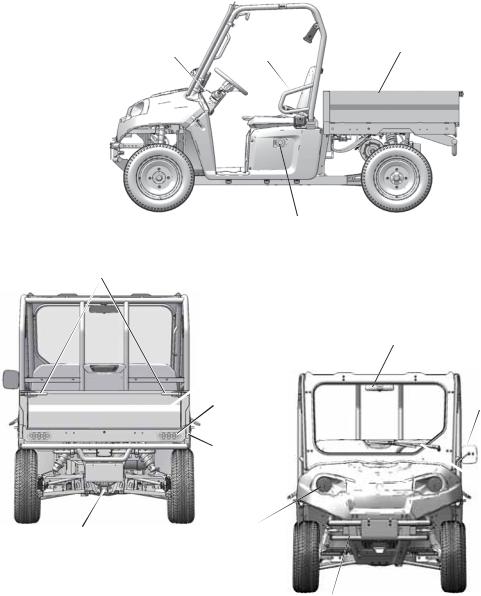
FEATURES AND CONTROLS
Component Locations
|
Hip |
Cargo |
|
Console |
Box |
||
Bar |
|||
|
Charge Receptacle
Tailgate
Latch Release
|
Rear View |
|
Mirror |
Tailgate |
Side View |
|
|
Taillight |
Mirror |
Reflector |
|
|
Windshield |
|
Wiper |
Receiver Hitch |
Headlight |
Front Bumper/Brush Guard
18

FEATURES AND CONTROLS
Console
1 |
2 |
3 |
4 |
5 |
6 |
7 |
8 |
15 |
14 |
13 |
12 |
11 |
10 |
9 |
1.Steering Wheel
2.Indicator Lights
3.Speedometer/Odometer
4.Headlight Switch
5.Charge Status indicator
6.Windshield Wiper Switch
7.Battery Discharge indicator
8.Glove Box/Storage Compartment
9.Beverage Holder
10.12V Auxiliary Outlet
11.Dump Box Switch (if equipped)
12.Seat Belt warning indicator
13.Direction Selector Switch
14.Key Switch
15.Turn Signal/Hazard Signal lever
19

FEATURES AND CONTROLS
Console
Battery Discharge Indicator
The battery discharge indicator displays the amount of charge removed (used) from fully charged batteries.
When the batteries are fully charged, the gauge will display 100%. The charge status indicator will be solid green (see page 21).
Avoid discharging the batteries more than 80%.
Hour Meter
The hour meter records and displays the hours of actual “key on” time since manufacture.
Auxiliary 12-Volt Terminal Board
The 12-volt terminal board is located under the hood. It contains constant 12-volt, switched 12-volt and ground terminals that can be used to power auxiliary lights and accessories. The terminals are limited to 10 amps.
Auxiliary Outlets
The 12-volt receptacle can be used to power accessories, but is limited to 10 amps (the terminal board and 12-volt outlet are fused together at 10 amps.
Direction Selector Switch
When the direction selector is in the center position, the vehicle is in neutral. The vehicle will not move if the accelerator is depressed.
Push the top of the switch to choose forward operation. Push the bottom of the switch to choose reverse operation. Always come to a complete stop before reversing direction.
Tip: The malfunction light will illuminate after reversing direction if you press the accelerator pedal before coming to a complete stop.
Forward
Neutral
Reverse
Headlight Switch
The ignition switch key must be in the ON/RUN position to operate |
High |
the headlights. Press the top of the rocker switch toward the dash to |
|
place the headlights on high beam. Move the rocker switch to the |
Low |
center position to place the headlights on low beam. Press the bottom |
|
of the rocker switch to turn off the headlights. |
Off |
|
20

FEATURES AND CONTROLS
Console
Park Brake Lever
To help prevent the vehicle from rolling, set the park brake when parking the vehicle. When the park brake is set and the park brake indicator is illuminated, motor speed is limited. If the accelerator is applied, this limiting feature prevents operation, which protects the park brake pads from excessive wear.
Tip: This feature will not operate properly if the park brake connector or switch (under the hood) malfunctions or becomes disconnected, or if the switch has moved. Check for disconnection, then see your dealer promptly if this feature fails to operate properly.
Always apply the service brakes before engaging or releasing the park brake.
1. |
Apply the brakes. |
|
2. |
Pull the park brake lever upward as far as |
|
|
possible. |
Set |
3. |
To release the park brake, apply the brakes. |
|
|
Press the park brake lever release inward |
|
|
and move the lever downward as far as |
Release |
|
possible. |
|
Charge Status Indicator
Brake Lever
Release
When charging the batteries, the charge status indicator light flashes and changes color to indicate the status of the charge. Refer to the table below.
Color |
Indication |
Code Definition |
|
|
|
Green |
Solid |
Charge is complete, charger is in maintenance mode. |
|
|
|
Green |
Fast Flash |
Less than 80% of charge is completed. |
|
|
|
Green |
Slow Flash |
More than 80% of charge is completed. |
|
|
|
Amber |
Flashing |
Power mode is reduced, low AC voltage or high internal |
|
|
charger temperature exists; remove seat to improve air flow. |
Red |
Flashing |
Charger error exists; reset charger power and refer to |
|
|
Troubleshooting Guide on page 25. |
Key Switch
Turn the key to the ON position to activate the electrical circuits.
Turn the key to the OFF position to disable all electrical circuits. The key can be removed from the switch when it is in the OFF position.
To prevent unnecessary battery drain, turn the key to the OFF position when the vehicle is idle. Always set the park brake and remove the key when leaving the vehicle unattended.
21
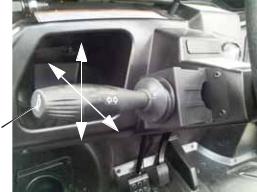
FEATURES AND CONTROLS
Console
Horn
Press the turn signal wand inward toward the instrument pod to sound the horn.
Turn Signal
The turn signal lever contains the controls for the turn signals, hazard signals and horn. Check turn signal lamps before each ride. When driving, activate a turn signal before turning to alert others of your intentions.
Tip: The key must be in the ON position to activate the turn signals.
Right Turn
Hazard
ON
Horn |
Hazard |
|
Left Turn OFF
Move the turn signal lever downward to signal a left turn. The left turn signal lamp below the front headlight will flash. The left turn indicator on the dash will also flash.
Move the turn signal upward to signal a right turn. The right signal lamp and indicator will flash.
Return the lever to the center position to end the signal. If the operator does not end the signal within 45 seconds, an alert will sound.
Hazard Signals
Push the turn signal lever forward to cause all turn signal lamps to flash simultaneously. Use this feature to alert others of an emergency or other situation requiring caution, especially if your vehicle becomes disabled on or near a road. Pull the turn signal lever rearward to cancel the hazard signals.
22
